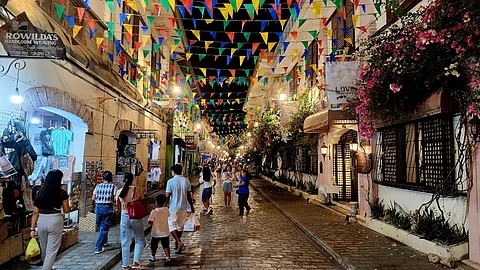
- NEWS
- the EDIT
- COMMENTARY
- BUSINESS
- LIFE
- SHOW
- ACTION
- GLOBAL GOALS
- SNAPS
- DYARYO TIRADA
- MORE

The magnitude-seven Luzon earthquake of 2022 damaged numerous buildings, many of which were ancestral homes that contribute significantly to the character of Vigan City, capital of Ilocos Sur and a UNESCO World Heritage site. The UNESCO Heritage Emergency Fund (HEF) was granted to the well-preserved former trading town in northern Philippines to aid in the recovery and to support enhancement of technical standards for the protection and conservation of historic structures and capacity-building activities for the local stakeholders. Last March marked the third quarter of the implementation of HEF.
UNESCO Jakarta, represented by its Culture Unit’s head Moe Chiba and project coordinator Rizky Fardhyan, visited Vigan City to observe and support the implementation of HEF. Their visit coincided with events around Vigan from 11 to 13 March, and they witnessed major milestones achieved by the expert teams, visiting and local students and professors, and the stakeholders of Vigan.
The HEF capacity-building training program was held at Vigan’s Conservation Complex, courtesy Vigan Mayor Jose “Bonito” Singson Jr., on 11 and 12 March. The University of Santo Tomas Graduate School Center for Conservation of Cultural Property and Environment in the Tropics (USTGS-CCCPET), partner and organizer of the program, gathered an expert team of architects, structural engineers and trades people to deliver the lecture series.
One compelling lecture was about the morphology of the Syquia Mansion. Conservation architect Michael Manalo described the growth in size of the house and the influence of international trading in the choice of materials to construct the house. This can be said about most ancestral houses of families who became wealthy and prominent during the golden era of commerce in Vigan.
In addition to the lectures, there were hands-on workshops explaining the characteristics of lime and lime mortar and traditional rough carpentry. A highlight of the workshops was a demonstration on mixing lime. Most participants had modern construction backgrounds and regularly used conventional materials. However, the workshop helped them understand the binding properties of lime, how it behaves and how it can be used. Emphasis was placed on the use of lime as an appropriate binder for the repair and reconstruction of ancestral houses. Master mason Shiela Soliveres commented that for many participants lime was unlike other binders they used before. Aside from the contractors, masons and carpenters, homeowners also participated in the program to have a close-up view of the materials that are traditionally used in Vigan.
To aid in the recovery of Vigan, further documentation of damaged houses was conducted. The University of Hong Kong (HKU) led by Dr. Linda Shetabi with 19 students partnered with 85 fifth-year Architecture students and 21 professors, led by dean and architect Fatima Nicetas Rabang-Alonzo, from the University of Northern Philippines (UNP) to document 15 priority ancestral houses damaged by the earthquake.
The HKU and UNP students used digital technology to create three-dimensional models of the houses and gathered data on their histories and damages. With the use of photogrammetry, a LIDAR scanner and mini-drones, the intensive documentation was rapid, concluding in less than one week. Each student team presented their findings at the knowledge-sharing session on 13 March at the Tadena Hall of UNP. The partnership between HKU and UNP further helped in the recovery by providing much needed documentation, which updated the 1996 Toyota Foundation-funded research inventory of 120 ancestral houses. Also, a relationship was forged between the two universities, which will lead for more bilateral cooperation.
The knowledge-sharing sessions also served as an avenue for delivering lectures on topics relevant to the recovery of Vigan, such as the evolution of local conservation practices, local challenges for heritage as a development tool, the characteristics of traditional building materials like wood, disaster risk management for cultural heritage, heritage conservation in the digital age and relationship between place and identity. The session allowed for different perspectives to be expressed, creating a space for inclusivity and learning.
A town hall meeting was held at conclusion of the session, gathering Vigan homeowners and local stakeholders to voice their opinions on issues on the recovery of the city. Homeowners suggested the creation of a specialized emergency response team with relevant specialists and experts, that more capacity-building sessions will be offered to all stakeholders to enhance skills and knowledge for conservation, and that guidelines for the restoration and repair of homes should be refined. The re-establishment of a homeowner’s association was also suggested so that knowledge can be shared immediately to all homeowners and challenges can be addressed with communal support.
Financing the repair of the homes was also a sensitive issue. Many of the homeowners now are abroad or in other parts of the country, resulting in landlord absenteeism. Many of these homes now belong to numerous family members who may not necessarily agree on issues for the care of their ancestral homes and who may not have the funds or means to maintain the structures. One suggested solution is the granting of tax breaks. With a sound legal framework and mechanism in place, a general fund can also be created. Participants also proposed exploring avenues for financial assistance, such as grants or subsidies, to support homeowners in repairs and restoration efforts.
Awareness has reached many concerned organizations and individuals, enabling them to bring together different kinds of assistance, bolstered by the UNESCO Heritage Emergency Fund and achieving milestones in the process of recovery. At this point, aids have already reached P2 million aside from in-kind contributions, significantly helping conserve a Philippine and world cultural treasure.
